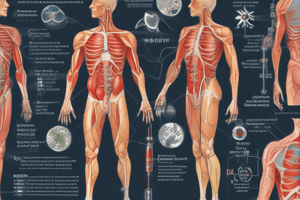Podcast
Questions and Answers
Which of the following conditions is associated with respiratory acidosis?
Which of the following conditions is associated with respiratory acidosis?
- Febrile conditions
- Hyperventilation
- Milk alkali syndrome
- Narcotics, Sedatives (correct)
What is the normal range for the anion gap?
What is the normal range for the anion gap?
- 10 ± 2 mEq/L
- 15 ± 5 mEq/L
- 12 ± 4 mEq/L (correct)
- 20 ± 3 mEq/L
Which of the following causes a high anion gap acidosis?
Which of the following causes a high anion gap acidosis?
- Lactic acidosis (correct)
- Renal tubular acidosis
- Cushing Syndrome
- Diarrhea
Which conditions are categorized under metabolic alkalosis?
Which conditions are categorized under metabolic alkalosis?
What characterizes a strong acid?
What characterizes a strong acid?
What does the anion gap calculation help to diagnose?
What does the anion gap calculation help to diagnose?
Which option represents a cause of metabolic acidosis with a normal anion gap?
Which option represents a cause of metabolic acidosis with a normal anion gap?
Which of the following represents a weak acid?
Which of the following represents a weak acid?
Which of these statements accurately describes a weak base?
Which of these statements accurately describes a weak base?
Which factors are included in calculating the anion gap?
Which factors are included in calculating the anion gap?
Which of the following is NOT considered a strong base?
Which of the following is NOT considered a strong base?
In metabolic acidosis, what is typically observed regarding pH levels?
In metabolic acidosis, what is typically observed regarding pH levels?
What is a primary method by which acids are produced in the human body?
What is a primary method by which acids are produced in the human body?
Which of the following is an example of an inorganic weak acid?
Which of the following is an example of an inorganic weak acid?
Which of these correctly describes the role of hydroxyl ions in bases?
Which of these correctly describes the role of hydroxyl ions in bases?
The Henderson-Hasselbalch equation is significant for understanding:
The Henderson-Hasselbalch equation is significant for understanding:
Which of the following is considered an alkaline substance in the human body?
Which of the following is considered an alkaline substance in the human body?
What does a lower pKa value indicate about an acid?
What does a lower pKa value indicate about an acid?
What does pH measure in a solution?
What does pH measure in a solution?
Which of the following statements regarding pKb is true?
Which of the following statements regarding pKb is true?
Which pH range indicates an acidic solution?
Which pH range indicates an acidic solution?
What is the dissociation constant (Ka) related to?
What is the dissociation constant (Ka) related to?
What does a pH of 7 indicate about a solution?
What does a pH of 7 indicate about a solution?
Which of the following organic acids is not considered an alkaline substance?
Which of the following organic acids is not considered an alkaline substance?
What typically causes an increase in the anion gap?
What typically causes an increase in the anion gap?
Which condition is associated with a high anion gap acidosis?
Which condition is associated with a high anion gap acidosis?
In metabolic acidosis, which bicarbonate level indicates an underlying problem?
In metabolic acidosis, which bicarbonate level indicates an underlying problem?
What should be done first in diagnosis of acid-base imbalances?
What should be done first in diagnosis of acid-base imbalances?
Which of the following values indicates a respiratory problem in acid-base balance?
Which of the following values indicates a respiratory problem in acid-base balance?
What signifies a normal serum bicarbonate level?
What signifies a normal serum bicarbonate level?
What clinical scenario might increase the likelihood of lactic acidosis?
What clinical scenario might increase the likelihood of lactic acidosis?
What does a low anion gap primarily suggest?
What does a low anion gap primarily suggest?
What is the normal pH range of human blood?
What is the normal pH range of human blood?
Which parameter indicates a metabolic acid-base disturbance?
Which parameter indicates a metabolic acid-base disturbance?
What is the primary buffer system in the human body?
What is the primary buffer system in the human body?
In the Henderson-Hasselbalch equation, what represents the weak acid?
In the Henderson-Hasselbalch equation, what represents the weak acid?
A patient has a pH of 7.30 and a pCO2 of 50 mmHg. What type of acid-base disturbance is likely present?
A patient has a pH of 7.30 and a pCO2 of 50 mmHg. What type of acid-base disturbance is likely present?
What is the most effective condition for a buffer to work according to the Henderson-Hasselbalch equation?
What is the most effective condition for a buffer to work according to the Henderson-Hasselbalch equation?
Which acid is chiefly produced during strenuous exercise due to lactic acid accumulation?
Which acid is chiefly produced during strenuous exercise due to lactic acid accumulation?
What is the primary organ responsible for regulating bicarbonate levels in the blood?
What is the primary organ responsible for regulating bicarbonate levels in the blood?
What would you expect the bicarbonate (HCO3-) levels to be in respiratory alkalosis?
What would you expect the bicarbonate (HCO3-) levels to be in respiratory alkalosis?
Which of the following statements is true regarding respiratory acidosis?
Which of the following statements is true regarding respiratory acidosis?
What happens to pH in metabolic alkalosis?
What happens to pH in metabolic alkalosis?
Which of the following substances is responsible for the regulation of intracellular pH?
Which of the following substances is responsible for the regulation of intracellular pH?
Which of the following conditions can lead to metabolic acidosis?
Which of the following conditions can lead to metabolic acidosis?
Flashcards
Strong Acid
Strong Acid
A strong acid completely dissociates into its ions in water.
Weak Acid
Weak Acid
A weak acid only partially dissociates into ions.
Strong Base
Strong Base
A strong base completely dissociates into its ions in water.
Weak Base
Weak Base
Signup and view all the flashcards
Acid (Arrhenius)
Acid (Arrhenius)
Signup and view all the flashcards
Base (Arrhenius)
Base (Arrhenius)
Signup and view all the flashcards
Acid-Base Equilibrium
Acid-Base Equilibrium
Signup and view all the flashcards
Henderson-Hasselbalch Equation
Henderson-Hasselbalch Equation
Signup and view all the flashcards
Acid Dissociation Constant (Ka)
Acid Dissociation Constant (Ka)
Signup and view all the flashcards
pKa
pKa
Signup and view all the flashcards
pH scale
pH scale
Signup and view all the flashcards
pH
pH
Signup and view all the flashcards
Acid-Base Balance
Acid-Base Balance
Signup and view all the flashcards
Neutral pH
Neutral pH
Signup and view all the flashcards
Acidic Substance
Acidic Substance
Signup and view all the flashcards
Alkaline Substance
Alkaline Substance
Signup and view all the flashcards
Anion Gap
Anion Gap
Signup and view all the flashcards
Normal Anion Gap
Normal Anion Gap
Signup and view all the flashcards
Anion Gap Calculation
Anion Gap Calculation
Signup and view all the flashcards
Metabolic Acidosis
Metabolic Acidosis
Signup and view all the flashcards
Causes of Elevated Anion Gap
Causes of Elevated Anion Gap
Signup and view all the flashcards
Causes of Normal Anion Gap
Causes of Normal Anion Gap
Signup and view all the flashcards
Significance of Anion Gap Calculation
Significance of Anion Gap Calculation
Signup and view all the flashcards
Diarrhea and Anion Gap
Diarrhea and Anion Gap
Signup and view all the flashcards
High Anion Gap Acidosis
High Anion Gap Acidosis
Signup and view all the flashcards
Normal Anion Gap Acidosis
Normal Anion Gap Acidosis
Signup and view all the flashcards
Arterial Blood Gas (ABG)
Arterial Blood Gas (ABG)
Signup and view all the flashcards
Compensation (Acid-Base)
Compensation (Acid-Base)
Signup and view all the flashcards
Serum Electrolytes
Serum Electrolytes
Signup and view all the flashcards
Normal Blood pH
Normal Blood pH
Signup and view all the flashcards
Primary Buffer System
Primary Buffer System
Signup and view all the flashcards
Respiratory Acidosis
Respiratory Acidosis
Signup and view all the flashcards
Lactic Acidosis
Lactic Acidosis
Signup and view all the flashcards
Bicarbonate Regulation
Bicarbonate Regulation
Signup and view all the flashcards
Buffer Effectiveness
Buffer Effectiveness
Signup and view all the flashcards
Respiratory Alkalosis
Respiratory Alkalosis
Signup and view all the flashcards
Bicarbonate (HCO3-) levels in Respiratory Alkalosis
Bicarbonate (HCO3-) levels in Respiratory Alkalosis
Signup and view all the flashcards
Metabolic Alkalosis
Metabolic Alkalosis
Signup and view all the flashcards
Study Notes
Acid and Base Concepts
- Acids release protons (H+) in water, acting as proton donors.
- Bases accept protons (H+) in water or release hydroxide ions (OH-).
- Each acid has a characteristic tendency to lose its proton (H+) in an aqueous solution. Stronger acids lose their protons readily while weaker acids release their protons slower.
Learning Objectives
- Unit 2: Acid and Base Concepts
- 2.1: The acid-base balance concept
- 2.2: Arrhenius definition
- 2.3: Acid-base equilibrium
- 2.4: Henderson-Hasselbalch equation
Arrhenius Definition of Acids and Bases
- Acids release protons (H+) in water (proton donors).
- Bases accept protons (H+) in water (proton acceptors) or release hydroxide ions (OH-).
- Each acid has a tendency to lose its proton (H+) in an aqueous solution;
Strong Acids
- Strong acids completely dissociate into ions in aqueous solution.
- Examples: HCl, H₂SO₄, HNO₃ (inorganic)
Weak Acids
- Weak acids partially dissociate into ions in aqueous solution.
- Examples: Formic acid (HCOOH), Acetic acid (CH3COOH), Oxalic acid (C₂H₂O₄), Benzoic acid (C₇H₅COOH), Lactic acid, Phosphoric acid, Carbonic acid, Citric acid.
- Weak acids are common in biological systems and are produced during metabolic processes.
Strong Bases
- Strong bases completely dissociate into ions when dissolved in solution.
- Examples: NaOH, KOH, Ba(OH)₂
Weak Bases
- Weak bases do not completely dissociate into ions when dissolved in solution.
- Examples: Amines, NH₄⁺, Aniline, Pyridine
Acids Produced in the Human Body
- Carbonic acid (oxidation of carbon compounds)
- Sulfuric acid (oxidation of sulfur-containing amino acids)
- Phosphoric acid (metabolism of dietary phosphoproteins, nucleoproteins, phosphatides)
- Organic acids (oxidation of carbohydrates, fats, and proteins)
- Iatrogenic acids (certain medicines, like NH₄Cl, mandelic acid).
Acidic Substances of the Human Body
- Carbonic acid (H₂CO₃)
- Phosphoric acid (H₃PO₄)
- Sulfuric acid (H₂SO₄)
- Organic acids (lactate, acetoacetate, pyruvate)
Alkaline Substances of the Human Body
- Citrate
- Bicarbonates
Dissociation Constant (Kₐ)
- The tendency of an acid (HA) to lose a proton (H+) and form its conjugate base (A⁻)
- Kₐ = [H⁺][A⁻] / [HA]
- pKₐ = -log Kₐ
- A measurement of acid strength; lower pKₐ values correspond to stronger acids.
pH
- pH is a measure of hydrogen ion (H⁺) concentration.
- pH = -log[H⁺]
- 0-7: Acidic
- 7: Neutral
- 7-14: Basic/Alkaline
Buffer Systems:
- Buffers resist changes in pH when acids or bases are added.
- Often mixtures of weak acids and their conjugate bases.
- Important in maintaining blood pH and physiological pH inside cells.
- Examples: Acetic acid (CH₃COOH) and acetate ion(CH₃COO⁻); Bicarbonate-carbonic acid buffer (HCO₃⁻/H₂CO₃); Phosphate buffer systems (HPO₄²⁻/H₂PO₄⁻); Protein buffers systems (e.g., hemoglobin, amino acids like histidine, cysteine)
Importance of Biological Buffers
- Maintaining homeostasis
- Regulating enzymatic function
- Controlling pH in biochemical reactions
Buffer Systems in the Human Body
- First line of defense against pH shifts (Chemical buffers) : Bicarbonate Buffer system, Phosphate buffer system, Protein buffer system
- Second line of defense against pH shifts (Physiological buffers): Respiratory and renal mechanisms
Bicarbonate Buffer System
- Major extracellular fluid buffer.
- Composition: Sodium bicarbonate (NaHCO₃) and carbonic acid (H₂CO₃).
- 20:1 ratio of bicarbonate to carbonic acid at pH 7.4. (ratio is maintained with the help of kidneys).
Phosphate Buffer System
- Important intracellular buffer.
- Composition: Mono hydrogen phosphate (HPO₂⁻) and dihydrogen phosphate ions (H₂PO₄⁻).
- 4:1 ratio of mono hydrogen phosphate to dihydrogen phosphate maintained by kidneys.
Protein Buffer Systems
- Includes hemoglobin and work inside blood.
- Amino acids compose proteins, with carboxyl groups releasing H⁺ and amino groups accepting H⁺.
- Side chains of amino acids (e.g., histadine,cystine) have buffering capacity.
Acid-Base Disorders
- Acidosis: pH < 7.35 (Respiratory acidosis, Metabolic acidosis)
- Alkalosis: pH > 7.45 (Respiratory alkalosis, Metabolic alkalosis)
Anion Gap
- Measures the difference between measured cations (Na+, K+) and measured anions (Cl-, HCO3-), providing insights into metabolic acidosis where unmeasured anions (PO4³⁻, organic acids, etc.) are elevated.
Significance of Anion Gap Calculation
- Helps diagnose acid-base imbalances,particularly metabolic acidosis.
- Helps in the diagnosis of several other conditions.
Acid-Base Disorders, Further Details for diagnosis and testing
- Provides detailed information about how to diagnose respiratory and metabolic acidosis and alkalosis including the various causes and examples of each.
Diagnostic Lab Values and Interpretations
- Provides a list of normal serum electrolyte and arterial blood gas values.
Case Study Examples
- A patient with a specific set of values providing examples of possible diagnosis of acid-base disturbances. (Page 55)
Additional Details and Important Considerations for Acid-Base Imbalance Diagnosis
- Further descriptions of acid-base imbalances including the various causes of each and examples of chronic conditions associated with each. This includes a stepwise approach. (Page 50)
- Explanation on how to determine the cause of the acid-base imbalance and further details on diagnosing and interpreting the findings. (Page 53)
Practiced Questions
- Provides set of questions to test the student's knowledge about the acid-base balance. (Page 60)
Studying That Suits You
Use AI to generate personalized quizzes and flashcards to suit your learning preferences.





